PLEASE NOTE: THIS PAGE HAS A LOT OF GRAPHICS.
PLEASE BE PATIENT AS THE PAGE LOADS.
updated 2/21/2000
THE BOEING 707 PAGE
(...continued...)
America's first. And finest.
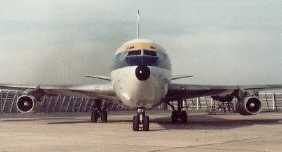
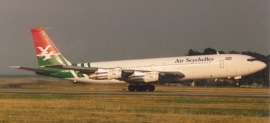
A great photo of an Air Seychelles 707-324C in
takeoff attitude at Frankfurt, West Germany.
Air Seychelles operated two 707s for a short time
prior to receiving their new Boeing 767. Air
Seychelles now has 2 767s and a 757.
I really like head-on views of the 707 the most. Here is
a really good view of a 720 conducting an engine run-up
after maintenance. You can see the smoke pouring out
of the number three engine (left engine in this photo).
The 707 and 720 in substance and form
BY THE NUMBERS
Different models of the 707 and 720 compared by dimensions and performance specifications.
707-100 707-300* 707-400* 720B#
Wingspan (ft/in) 130'10" 145'9" 142'5" 130'10"
Length (ft/in) 138'10" 145'6" 145'6" 128'10"
Passengers (first/coach) 39/85 14/133 14/133 26/98
Max. Takeoff Weight 258,000lbs 336,000lbs 296,000lbs 235,000lbs
Max. Landing Weight 185,000lbs 247,000lbs 195,000lbs 175,000lbs
Cruise speed (mph) 605 605 605 600
Max. Range (miles) 3,075 6,160 5,900 4,150
Notes:
* - the 707-300 and -400 are considered the "Intercontinental" models, with more powerful turbofan engines,
higher gross weights and longer range. Any airplane denoted with a "B" indicates a turbofan engine.
# - the 720B is also a re-engined version of the original 720 model with turbofan engines, and as above, allows
a higher gross weight and higher cruising speed.
A good three view drawing of a 707-320C
Intercontinental model. The "C" designation indicates either "Cargo"
or "Convertible" (convertible from cargo
to passenger service, as needed), and
the large door on the forward left side
of the airplane indicates that this is
indeed a cargo version. The main differ-
ences between a pure passenger airplane
and an all cargo model is usually a
stronger cabin floor (to accomodate the
heavier loads cargo will impose on it),
and a beefed-up undercarraige to allow
for higher landing weights.
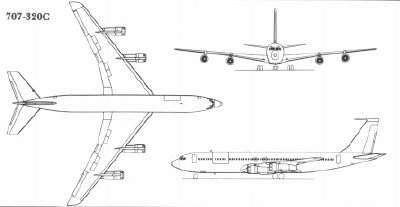
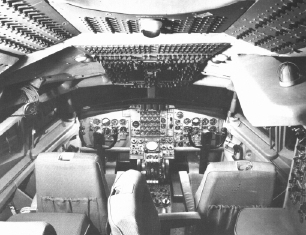
So what good would a web page about an airplane without
a picture of its flight deck? Okay, well, here it is! This is
a view of an early model 707, most likely a series -100,
although the flight decks of the later models were pretty much
similar. The 707s were configured for three flight crew
members: Captain(on the left, in front), First Officer(right),
and Flight Engineer (in back, seated sideways...its called
riding "sidesaddle"). You can tell this is a picture of an
older model airplane in that it has analog instrumentation
(dials and gauges), instead of CRT and flat display monitors
that the new technology airplanes have. Compared to
modern jetliners, the 707 had very little automation; cockpit
workload was heavy compared to the airplanes of today.
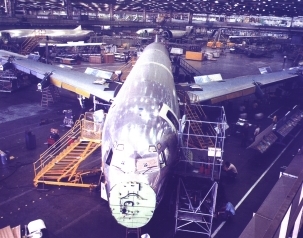
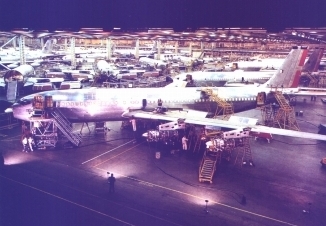
Two photos of 707s in various stages of assembly. In the left photo, a 707-300 Intercontinental series is being
built for the Chinese government . Boeing has since sold a lot of airplanes to China following President Nixon's
visit in 1972. In the right photo, two American Airlines 707-100 series are being assembled in the foreground,
with Air Force KC-135 Stratotankers undergoing assembly in the background. The KC-135 is commonly
referred to as the "military version of the 707", which, in form, is somewhat true, but from a technical aspect
is incorrect; the 707 and the KC-135 are very different aircraft, when comparing dimensions and performance
specifications.
Go to
Site Map
Go back
one page
Send me
an e-mail!!
Go to
next page
Boeing, the Boeing logo, and all associated aircraft designs and designations are registered trademarks
of The Boeing Company, Seattle, WA, USA.